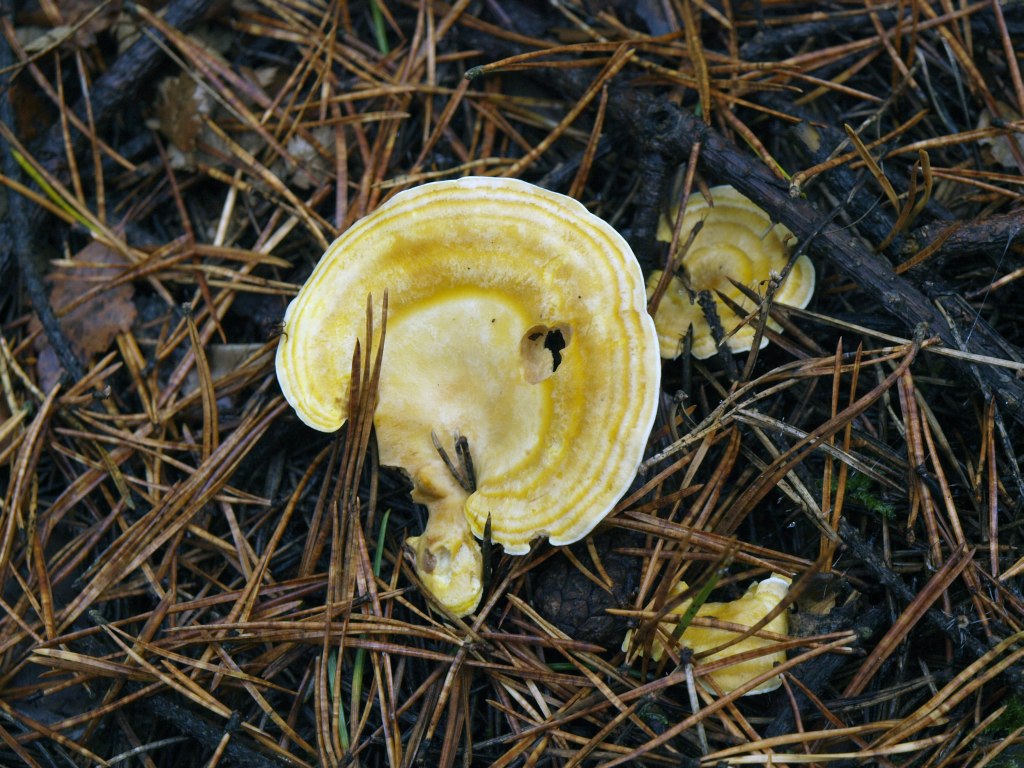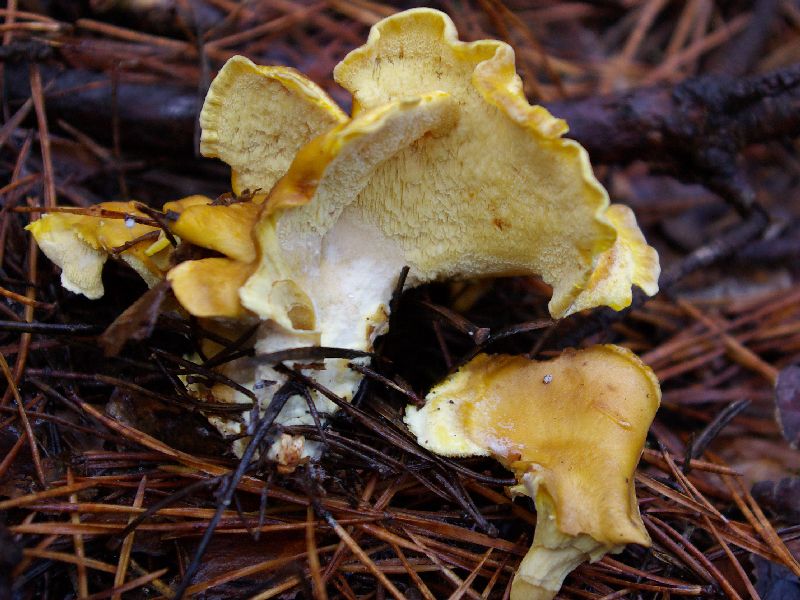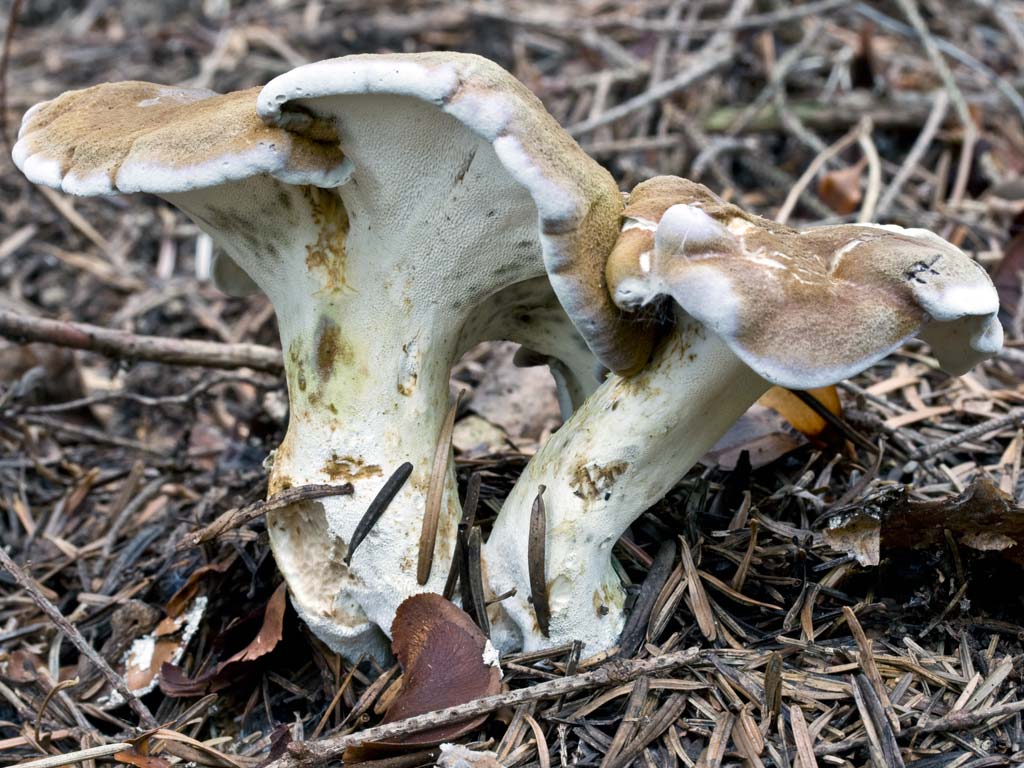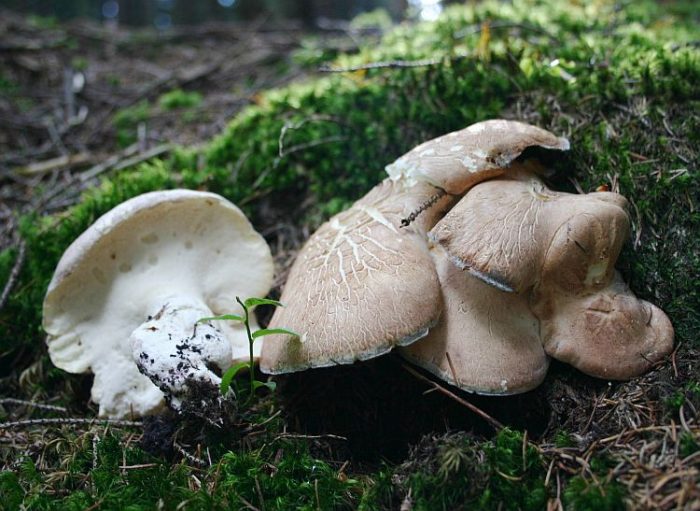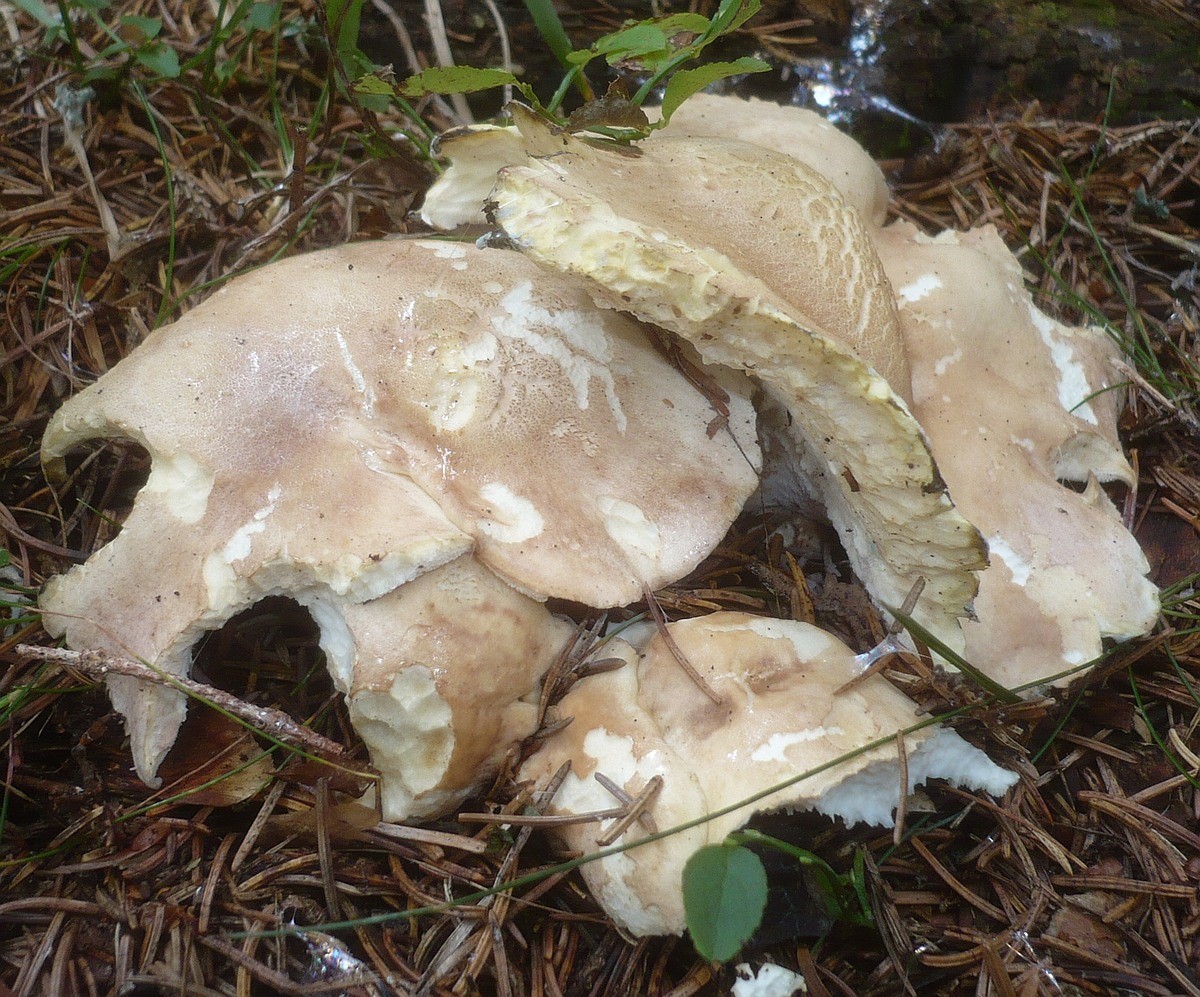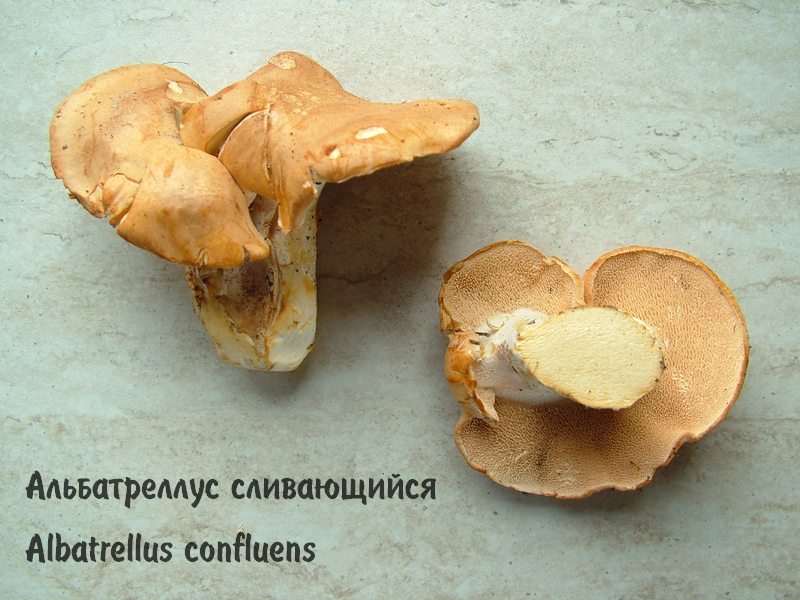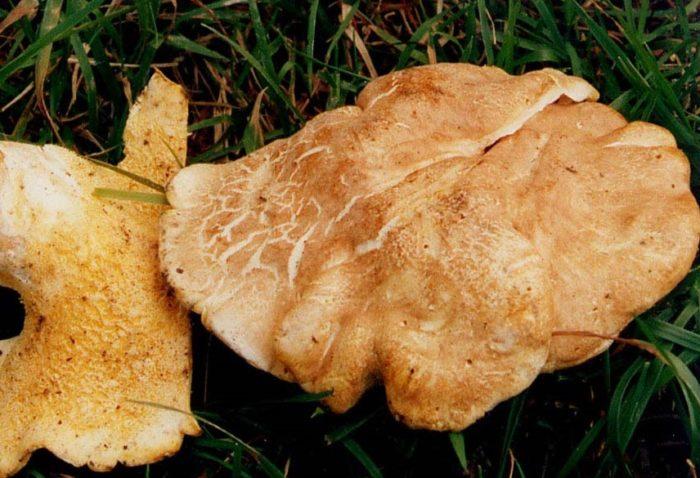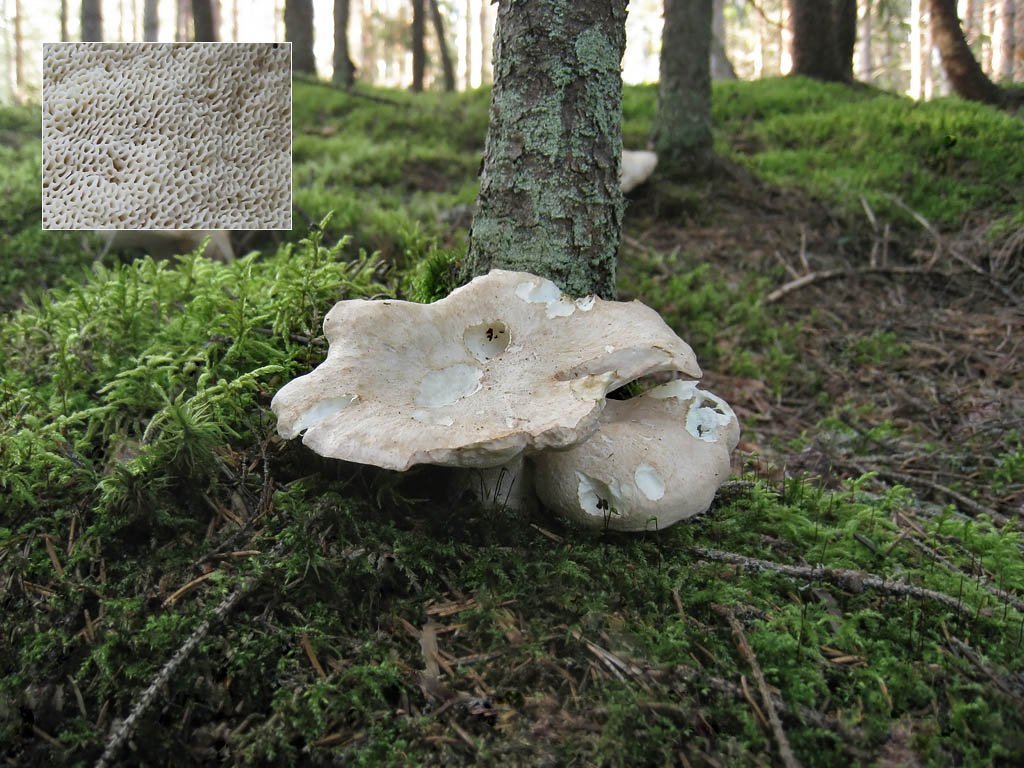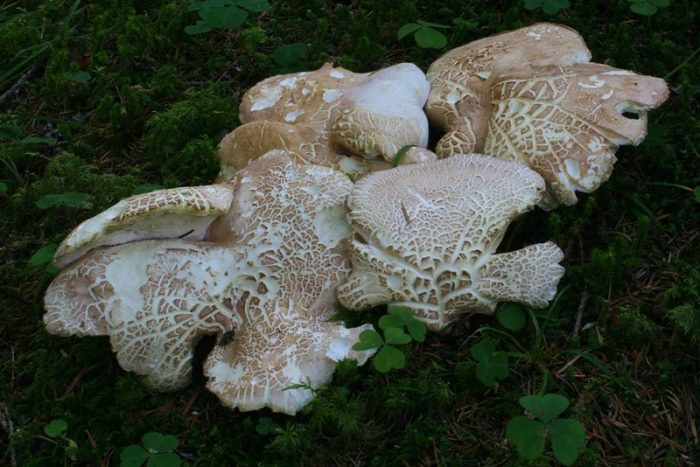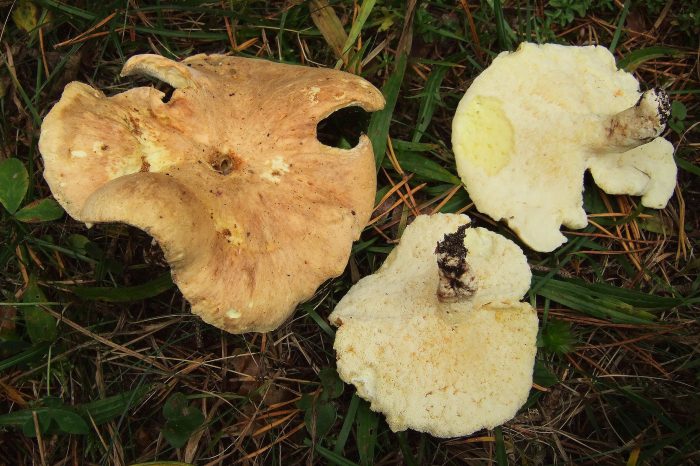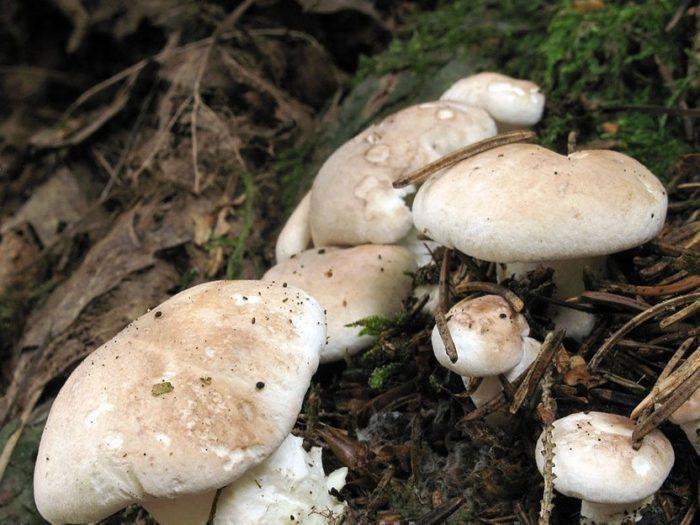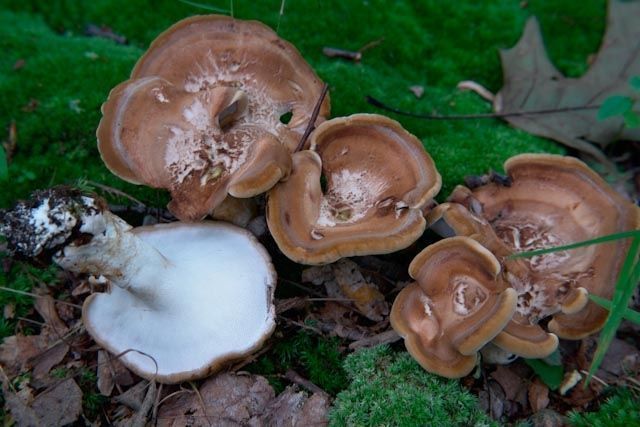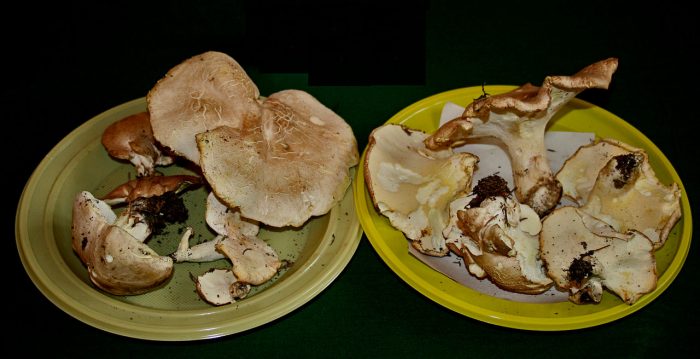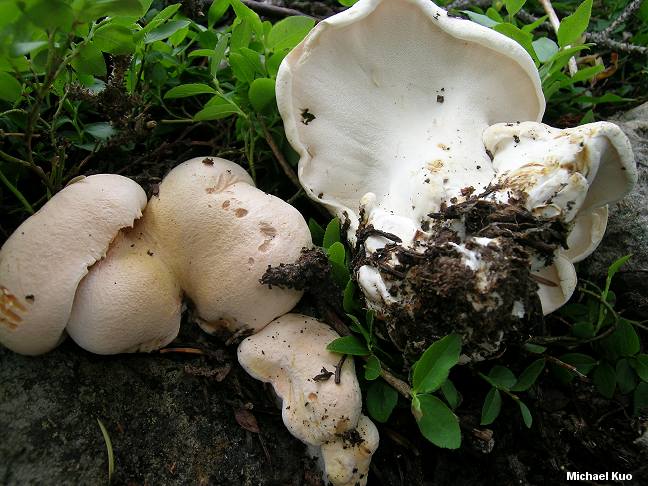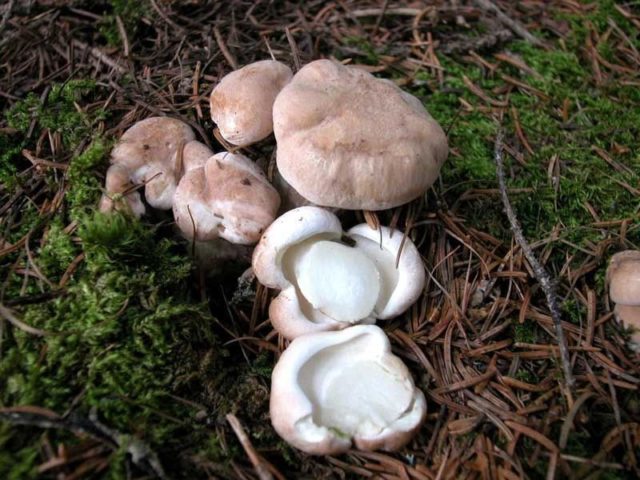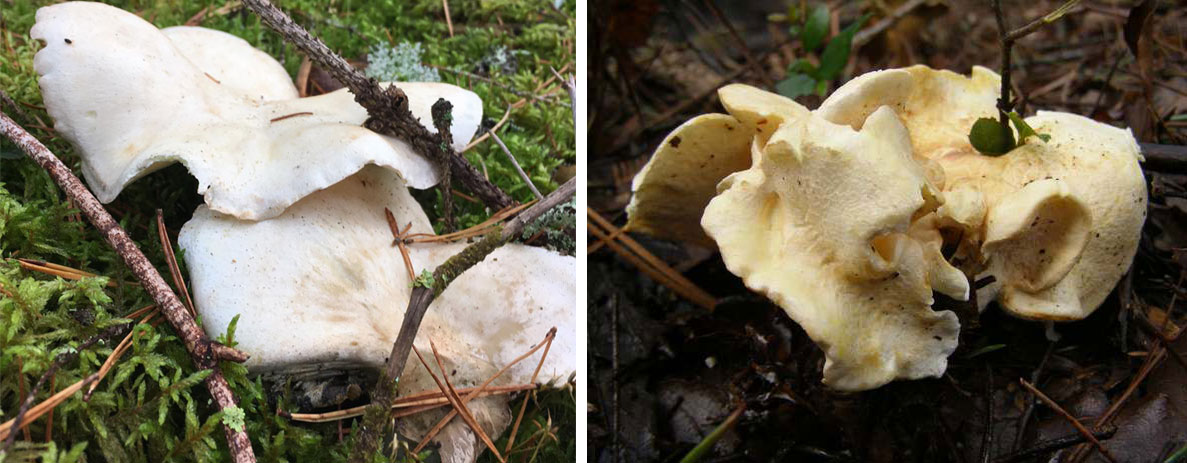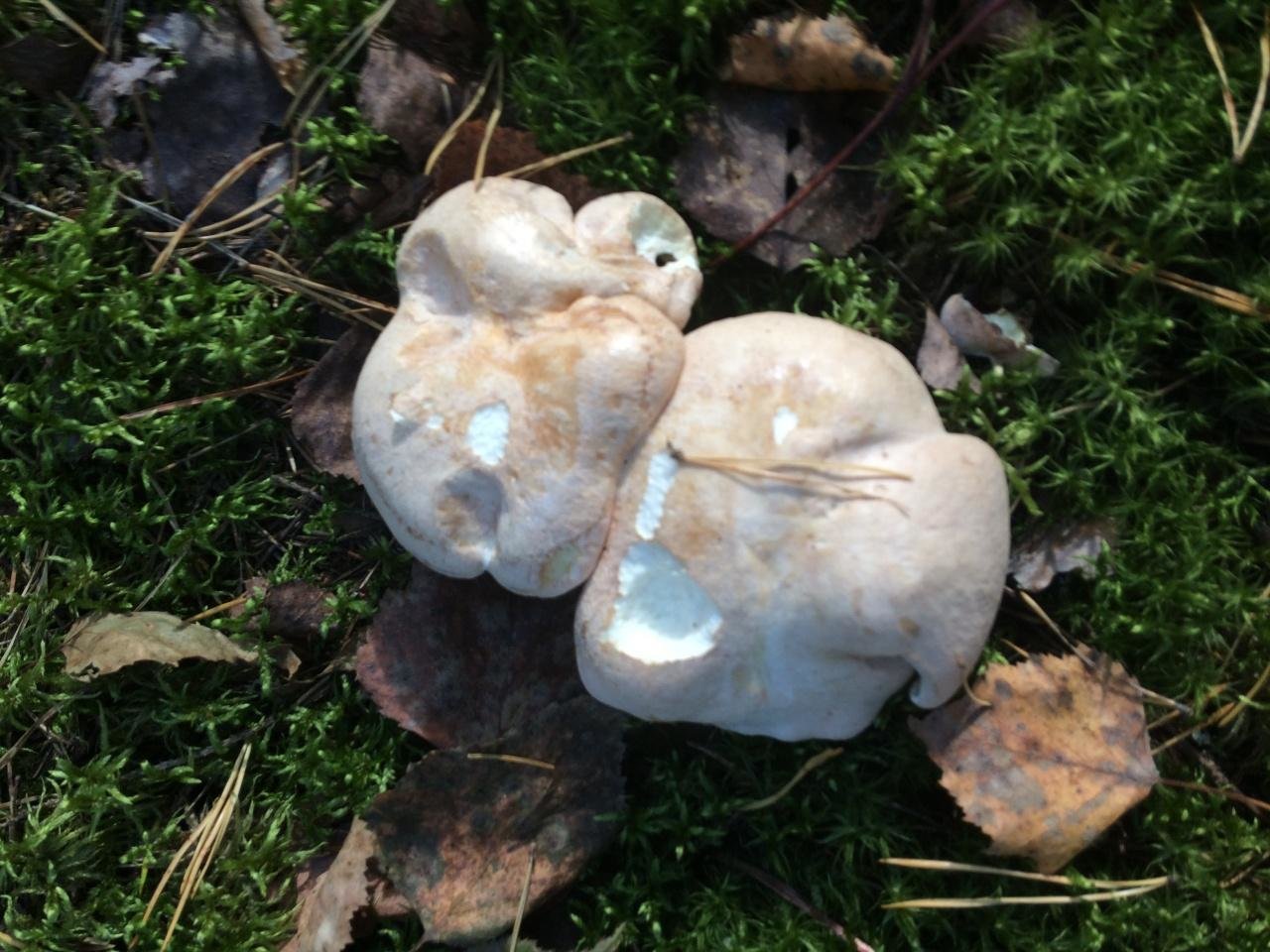Synonyms [| code]
- Albatrellopsis confluens (Alb. & Schwein.) Teixeira, 1993
- Boletus artemidorus Lenz, 1830
- Boletus aurantius Schaeff., 1774
- Boletus confluens Alb. & Schwein., 1805: Fr., 1821 basionym non Boletus confluens Schumach., 1803, q. e. Coltricia perennis (L.: Fr.) Murrill, 1903
- Boletus nitens J.F. Gmel., 1792
- Caloporus confluens (Alb. & Schwein.) Quél., 1888
- Caloporus politus (Fr.) Quél., 1886
- Cladomeris confluens (Alb. & Schwein.) Quél., 1886
- Merisma confluens (Alb. & Schwein.) Gillet, 1878
- Polypilus confluens (Alb. & Schwein.) P. Karst., 1881
- Polyporus artemidorus (Lenz) Fr., 1838
- Polyporus confluens (Alb. & Schwein.) Fr., 1821
- Polyporus laeticolor (Murrill) Sacc. & D. Sacc., 1905
- Polyporus pachypus Pers., 1825
- Polyporus politus Fr., 1836
- Polyporus whiteae (Murrill) Sacc. & D. Sacc., 1905
- Scutiger confluens (Alb. & Schwein.) Bondartsev & Singer, 1941
- Scutiger confluens f. politus (Fr.) Bondartsev, 1953
- Scutiger laeticolor Murrill, 1903
- Scutiger whiteae Murrill, 1903
Description of albatrellus confluent
The caps of confluent albatrellus can be of several types: rounded, with uneven sides, and unilaterally elongated. The diameter of the cap is 4-15 centimeters.

The legs of these mushrooms are lateral, up to 7 cm long and 1-3 cm in diameter, fleshy and quite brittle. The mushrooms grow together with the legs and edges of the caps, as a result they look like a shapeless mass, the diameter of which can be 40 centimeters or even more. Because of this, albatrellus were called merging or accrete. The tissues of these mushrooms are wide with thin walls, there are a large number of partitions and buckles.
In young mushrooms, the surface of the caps is smooth, but over time it becomes rough, and small scales may appear in the center. Later, the caps may crack. Due to the lack of moisture, the caps can crack even in young mushrooms.
The color of the cap is initially yellow-pink or cream with a reddish tint. But over time, a red or brown-pink color appears. When the mushrooms dry up, they generally become dirty red in color. The tubular layer of young fruit bodies is cream or white, and after drying, a pink or red-brown color appears.
The edges of the cap can be lobed or sharp. The skin is fleshy, slightly hard, its thickness can be up to 2 centimeters. The length of the tubes reaches 0.5 centimeters. The pores are angular or rounded. As they grow older, the edges of the tubes turn into dissected thin matter. Basidia are clavate. Ellipsoidal spores.

Areas of growth of confluent albatrellus
These fungi can be found in soil surrounded by moss. Most often, merging albatrellus are found in coniferous forests, especially in those where a large number of spruces grow. Less commonly, they can be found in mixed forests. Fusing albatrellus are common in Germany, Norway, Sweden, Finland, Estonia and Ukraine. They also grow in Japan, Australia and North America. In our country, they are collected in Siberia and the Urals.
Synonyms
- Albatrellopsis confluens (Alb. & Schwein.) Teixeira, 1993
- Boletus artemidorus Lenz, 1830
- Boletus aurantius Schaeff., 1774
- Boletus confluens Alb. & Schwein., 1805: Fr., 1821 basionym non Boletus confluens Schumach., 1803, q. e. Coltricia perennis (L.: Fr.) Murrill, 1903
- Boletus nitens J.F. Gmel., 1792
- Caloporus confluens (Alb. & Schwein.) Quél., 1888
- Caloporus politus (Fr.) Quél., 1886
- Cladomeris confluens (Alb. & Schwein.) Quél., 1886
- Merisma confluens (Alb. & Schwein.) Gillet, 1878
- Polypilus confluens (Alb. & Schwein.) P. Karst., 1881
- Polyporus artemidorus (Lenz) Fr., 1838
- Polyporus confluens (Alb. & Schwein.) Fr., 1821
- Polyporus laeticolor (Murrill) Sacc. & D. Sacc., 1905
- Polyporus pachypus Pers., 1825
- Polyporus politus Fr., 1836
- Polyporus whiteae (Murrill) Sacc. & D. Sacc., 1905
- Scutiger confluens (Alb. & Schwein.) Bondartsev & Singer, 1941
- Scutiger confluens f. politus (Fr.) Bondartsev, 1953
- Scutiger laeticolor Murrill, 1903
- Scutiger whiteae Murrill, 1903
Albatrellus ovinus (Albatrellus ovinus)
Other names:
- Scutiger ovinus
Albatrellus ovine, ovine mushroom (Albatrellus ovinus) grows in dry pine and spruce forests. Belongs to the well-known mushroom family Tinder fungus.
Description:
The round mushroom cap reaches ten centimeters in diameter. In an old mushroom, it cracks. The skin of the cap of the young mushroom is dry and silky to the touch. The lower surface of the mushroom cap is covered with a fairly dense layer of white-colored tubes, which are easily separated from the mushroom pulp. The surface of the cap is dry, naked, at first smooth, silky in appearance, then slightly scaly, cracking in old age (especially during dry periods). The edge of the cap is thin, sharp, sometimes pubescent, from slightly wavy to lobed.
The tubular layer strongly descends on the leg, the color varies from white or cream to yellow-lemon, greenish-yellow, turns yellow when pressed. The tubules are very short, 1–2 mm long, the pores are angular or rounded, 2–5 per 1 mm.
The stem is short, 3 - 7 cm long, thick (1 - 3 cm thick), strong, smooth, solid, central or eccentric, narrowed towards the base, sometimes slightly bent, from white (cream) to gray or light brown.
Spore powder is white. The spores are almost round or ovoid, transparent, smooth, amyloid, often with large drops of fat inside, 4 - 5 x 3 - 4 microns.
The pulp is dense, damp, brittle, white, yellow or yellowish-lemon when dry, often turns yellowish when pressed. The taste is pleasant, soft or slightly bitter (especially in old mushrooms). The smell is rather unpleasant, soapy, but according to some literary data, it can be both inexpressive and pleasant, almond or slightly mealy. A drop of FeSO4 stains the flesh gray, KOH stains the flesh a dirty golden yellow color.
Spreading:
Albatrellus ovine occurs infrequently from July to October on the soil under spruces in dry coniferous and mixed forests in clearings, clearings, forest edges, along roads, and also in the mountains. Prefers neutral and alkaline soils, often grows in moss. Forms clusters and groups with closely adhered to each other, sometimes growing together, legs and edges of caps, fruit bodies. Single specimens are less common. The species is widespread in the northern temperate zone: it is recorded in Europe, Asia, North America, and also found in Australia. On the territory of Russia: in the European part, Siberia and the Far East. Moss cover is considered a favorite place for growth. Tinder fungus is a rather large mushroom. It grows singly or in groups, sometimes growing together with its legs.
Similarity:
Ovine albatrellus in its appearance is similar to the confluent tinder fungus, which has a more brown color. Yellow blackberry (Hydnum repandum) is distinguished by a hymenophore, consisting of thick light creamy spines slightly descending on the leg. Albatrellus confluens is colored orange or yellow. brown tones, with a bitter or sour taste. It has accrete, usually uncracking caps, grows under various conifers. Albatrellus subrubescens is colored orange, light ocher or light brown, sometimes with a purple tint. The tubular layer is light orange. Grows under pine and spruce trees, has a bitter taste. Albatrellus cristatus has a brown-green or olive cap, grows in deciduous forests, most often in beech groves. Lilac albatrellus (Albatrellus syringae) is found in mixed forests, colored in golden yellow or yellowish brown tones. The hymenophore does not descend on the leg, the pulp is light yellow.
Grade:
Albatrellus ovine is a little-known edible mushroom of the fourth category. The mushroom is suitable for consumption only in an unripe form. Young caps of this mushroom are used fried and boiled, as well as stewed. Before use, the mushroom must be boiled with the preliminary removal of the lower part of its leg. In the process of boiling, the mushroom pulp acquires a yellowish-green color. The mushroom is considered especially tasty when fried raw without preliminary boiling and heat treatment. Ovine albatrellus can be pickled with spices for long-term storage.
The species is listed in the Red Book of the Moscow Region (category 3, a rare species).
Used in medicine: scutigeral, isolated from the fruiting bodies of ovine tinder fungus, has an affinity for dopamine D1 receptors in the brain and may act as an oral pain reliever.
Terrestrial telephony (Thelephora terrestris)
Fruit body:
the fruit body of the Telephora consists of shell-shaped, fan-shaped or rosette-shaped lobed caps, which grow together radially or in rows. The caps often form large irregular structures. Sometimes they are resupinant or prostrate-bent. The diameter of the cap is up to six centimeters. Growing together - up to 12 centimeters in diameter.At the narrowed base, the caps rise slightly, fibrous, pubescent, scaly or furrowed. Soft, concentrically zoned. Changes in color from reddish brown to dark brown. With age, the caps turn black, sometimes purple or dark red. At the edges, the cap retains a grayish or whitish color. Smooth and straight edges, later become carved and grooved. Often with small fan-shaped outgrowths. On the underside of the cap there is a hymenium, radially ribbed, warty, sometimes smooth. Hymenium is chocolate brown or reddish amber in color.
Hat:
The flesh of the cap is about three millimeters thick, fibrous, flaky-leathery, of the same color as hymenium. It is characterized by a light earthy odor and a mild taste.
Disputes:
purple-brown, angular-ellipsoidal, covered with blunt spines or tuberous.
Spreading:
Telefora Terrestrial, refers to saprotrophs growing on soil and symbitrophs that form mycorrhiza with coniferous tree species. Occurs on sandy dry soils, cutting areas and forest nurseries. Despite the fact that the fungus is not a parasite, it can lead to the death of plants, enveloping the seedlings of pine and other species. Such damage, foresters call suffocation of seedlings. Fruiting from July to November. A common species in forest areas.
Edibility:
not consumed.
Similarity:
Terrestrial Telefora, reminds Telephura Clove, which is also not used for food. The Clove Telephon is characterized by a goblet shape of small fruiting bodies, a central stalk and deeply dissected edges.
Notes:
the fruiting body of the fungus is formed next to the seedling of a pine or any other tree. At the same time, it can envelop the seedlings, which leads to their death. But, this mushroom is not considered a parasite, since seedlings serve as props for it. However, this fungus can cause serious damage in forest nurseries. If the fungus does not find suitable support, it forms fruiting bodies on the underside of dead branches or on small stones.
Albatrellus lilac Albatrellus syringae
Syn: Scutiger syringae Parmasto, 1962 Xanthoporus syringae (Parmasto) Audet, 2010
Description by Andrey Yakimenko and Tatiana Svetlova.
Click on the marker to get additional information about the find of this species If you still know the place of growth of this species, please determine its coordinates and send them to the site
Basic information Additional Section-3
On off. mushroom find map
| Full scientific name of this species: Albatrellus syringae (Parmasto) Pouzar, 1966 |
This species belongs to tinder fungi, despite the fact that it lives on the soil and has fruiting bodies with a cap and a leg. The hats are yellow and usually have a few darker areas; legs narrowed towards the base, with mycelial cords. Fruiting bodies very often grow together with the legs and edges of the caps in several copies. It grows near the trunks and stumps of lilacs and some other hardwoods. Rare view. (Tatiana Svetlova)
Common names
FI: Keltakääpä (Finland) DE: Wiesen-Porling; Gezonter Porling (Germany) DK: Gul Fåreporesvamp (Denmark)
Sporecap fruiting body
Fruiting bodies are annual, consisting of a cap and a leg, single or accrete, 2-4 specimens. Caps 3 - 12 cm in diameter up to 1 cm thick, with a thinner, sharp wavy or lobed edge, rounded, kidney-shaped, funnel-shaped, sometimes convex in the center. The surface is glabrous or slightly pubescent, yellow-cream, ocher-yellow, clearly or indistinctly zoned, with darker zones, often egg-yellow along the edge, brownish in old age.
Hymenophore Hymenophore
Tubules descending along the stem, up to 3 mm long, thick-walled. The surface of the hymenophore is pale lemon, yellow-cream, later dirty yellow with a whitish bloom. The pores are rounded, angular, sometimes with ciliate margins, 3-4 (5) per 1 mm.
Micromorphology Micromorphology
The hyphalous system is monomytic. The hyphae of the tissue of the cap and legs are densely woven, hyaline, branching, sinuous, thin-walled, with a varying diameter from 3 to 15 microns, in swellings up to 25 microns in diameter, with small buckles. The hyphae of the tubules are parallel tightly woven, often with granular contents, 2-5 µm in diameter. Basidia are clavate, with a buckle at the base, 15–25 x 5–7 µm, with 4 sterigmas 2–4 µm in length. Spores are broadly ellipsoidal, flattened on one side, hyaline, with a large droplet, 3.5 - 5 x 2.5 - 3.5 µm.
Stem leg
The leg is densely fleshy, brittle, somewhat fibrous, often central, 1 - 7 cm long, 1 - 2 cm in diameter, tapering towards the base, with mycelial cords. The color is cream, ocher yellow. In old fruiting bodies, the stem may be hollow.
Flesh pulp
The tissue of the cap is fleshy, slightly fibrous, zoned, whitish or dark creamy with a pleasant nutty flavor; dry hard and brittle.
Habitat habitat
Grows on soil in parks, forests, near the trunks or stumps of lilac, willow, linden, alder.
Distribution of Areal
The species is common in Europe, Asia, North America. On the territory of Russia, it was noted in the European part (Moscow region), Western Siberia (Yamalo-Nenets Autonomous Okrug), Irkutsk region, in the Far East.
Calendar Calendar
It grows from spring to late autumn.
Edibility Edibility
Edible.
Remarks
The species is included in the Red Lists of the following European countries: Estonia (CR), Norway (LC). It is not listed in the Red Data Books of the constituent entities of the Russian Federation, as well as the Red Data Book of Russia. Note: in brackets is the status that characterizes the degree of rarity of the described species in a given country.
Taxon authors: Parmasto - Parmasto, Erast (1928-), Estonian botanist and mycologist - described this species as Scutiger syringae; Pouzar - Pouzar, Zdenek (1932-), Czech mycologist.
Description
Fruiting bodies are cap-stalk, annual, often in the form of several caps on a branched stalk. Caps are from rounded to fan-shaped or irregularly lobed, up to 11 cm in greatest dimension and up to 3 cm thick, the upper surface is pinkish-beige, salmon-pink when dry, often cracking into separate areas with age.
The hymenophore is tubular, cream-colored, when it dries, it becomes salmon pink. Pores from rounded to angular, 3-5 per millimeter, with thick septa.
The stem is central to lateral, cream or pinkish-beige, naked, when dry salmon-pink, wrinkled, up to 8.5 cm long.
The pulp is soft and fleshy, creamy, when dry it is pinkish-yellowish-brown, when it dries, it is tough, resinous, often with a pleasant smell, with a peculiar cabbage taste and a bitter aftertaste.
The hyphalous system is monomytic. Cystyds are absent. Basidia are tetrasporous, clavate, 20–30 × 6–7.5 µm. Spores ovoid or elliptical, uncolored, 4-5 × 2.5-3.5 µm.
Place of growth
Mushroom picking takes place between July and October. It is rare, but in large groups. All types of ruddy are considered edible, but are poorly digested in the human body due to their tough pulp. In many countries, it is listed in the Red Book. The grown albatrellus grows on the ground surrounded by moss. In most cases, it grows in various types of pine forests (spruce forests), less often in different types of forests. Preferably in acidic soils and foothills. The distribution space is limitless and varied. In Europe, it can be found in countries such as Germany, Finland, Sweden, Norway. In East Asia, only in Japan. North America and Australia. And if you want to pick this mushroom in the Russian Federation, you should go to the Urals or Siberia.
Edible albatrellus sheep
Ovine albatrellus is an edible mushroom that is used fresh, dried, pickled, boiled, fried, stewed. It is a tasty mushroom, but its tough flesh is difficult to digest and can cause gastrointestinal upset.
They eat the caps of young mushrooms, which are boiled before use. When boiled, the flesh of the mushroom turns yellowish-green. Another cooking method is to fry raw albatrellus without boiling. Also, the mushroom is pickled with spices, which allows it to be stored for a long time.
Albatrellus is dried in the sun, in an oven, in an oven or on a gas stove.Drying outdoors requires sunny, dry weather to keep the mushrooms from spoiling. Fresh healthy mushrooms are cleaned, wiped with a damp cloth and sized. It is not necessary to wash the mushrooms, as they absorb moisture well and then dry out poorly. Then they are strung on a thread or hairpins. Albatrellus dries unevenly, so you need to monitor the process. An overdried mushroom will lose its taste, and an underdried mushroom will quickly deteriorate. When finished, dried albatrellus becomes light and dry, and tastes and smells like a fresh mushroom. Dried mushrooms are stored in dry, well-ventilated rooms, in sealed metal or glass jars.
Another way to store sheep's albatrellus is salting and pickling. Mushrooms are salted in a bowl made of wood, glass or enamel. Peeled and washed mushrooms are boiled in salted water for half an hour. The water is drained, the mushrooms are thrown into a colander and put in a container for salting. Salt is added at the rate of 50-60 g per 1 kg of mushrooms. Garlic, pepper, bay leaf are also added. Then they put him under oppression. A delicious dish is ready in a week. Salted albatrellus is stored in cool rooms. The brine should completely cover the mushrooms.
A delicious soup is made from albatrellus. 1 kg of fresh mushrooms is sorted out, peeled, legs removed and washed. Mushrooms are cut small, filled with water and boiled for 15–20 minutes. 4 onions are sautéed in vegetable oil. To boiled mushrooms add 350 g of any cereal, fried onions, chopped herbs, seasonings and bring to readiness.
Albatrellus is also used for preparing main courses and salads. For example, rolls made from these mushrooms are popular. Fresh mushrooms are boiled and fried, after which they are ground into minced meat with onions, garlic, salt and pepper. Chopped boiled eggs and mayonnaise are added to the finished minced meat. Sausages are formed from the mixture, which are wrapped in slices of ham. Rolls are laid out on a dish and poured with meat jelly, cooled.
Salads are prepared from pickled albatrellus: 1 kg of pickled mushrooms is cut and finely chopped green onions are added. Diced boiled potatoes (300 g) and a jar of green peas are added to the mixture. Dress the salad with mayonnaise, seasonings - salt and pepper.
Albatrellus cristate (Laeticutis cristata)
Synonyms:
Albatrellus cristatus
Photo Credit: Zygmunt Augustowski
Basidiomas in this fungus are annual. Sometimes they are solitary, but it is much more common that they grow together at the base, and the edges of the caps remain free.
Faced with Albatrellus comb, you can see a hat with a diameter of 2-12 cm and a thickness of 3-15 mm. The shape is round, semi-round and kidney-shaped. Often mushrooms are irregular in shape and depressed towards the center. In old age and with dryness, they become very brittle.
The top is thinly pubescent. Later, it begins to become more and more rough, breaks and scales at the center become visible. The surface of the hat has an olive-brown, yellowish-green, less often red-brown bloom, with a greenish tint at the edges.
The edge itself is very flat and coarse. The fabric of this representative of Albatrell is white, but towards the middle it becomes noticeably yellow, even lemon. Differs in fragility and fragility. The smell is slightly sour, the taste is not particularly pungent. Thickness up to 1 cm.
The tubes of this mushroom are rather short. only 1-5 mm in length. They are downhill and white. Like all mushroom breeds, they change their color when dried. It takes on a yellow, dirty yellow or red hue.
Pores tend to enlarge with age. Initially, they are small in size and round in shape. Placed with a density of 2-4 by 1mm. Over time, they not only increase in size, but also change shape, look more angular. The edges become scored.
The stem is central, eccentric, or nearly lateral. It has a white color, often set off by marble, lemon, yellow or olive colors.Leg length up to 10 cm and thickness up to 2 cm.
Albatrellus comb has a monomytic hyphal system. The tissues are wide with thin walls, the diameter varies (the diameter ranges from 5 to 10 microns). No buckles. The hyphae of the tubules are located rather consistently, have thin walls and are branched.
Basidia are club-shaped, and the spores are elliptical, spherical, smooth, hyaline. They have thickened walls and are drawn obliquely near the base.
Found in deciduous and mixed forests, where there are oaks and beeches. Germinate on a sandy soil surface. Often found on roads that are overgrown with grass.
The geographical location of Albatrellus crested is Russia (Krasnodar, Moscow, Siberia), Europe, East Asia and North America.
Eating: Not edible mushroom, because it is tough enough and has an unpleasant taste.

